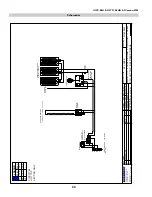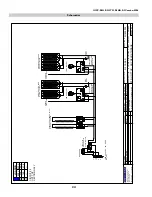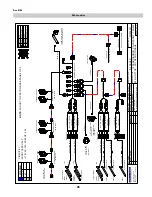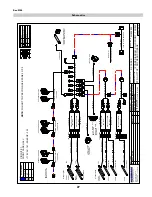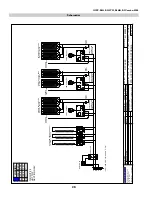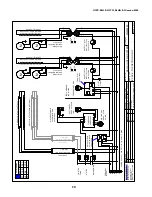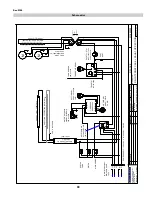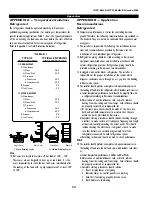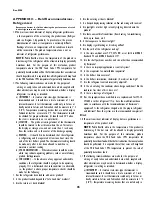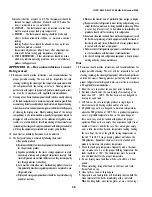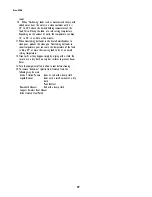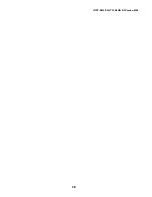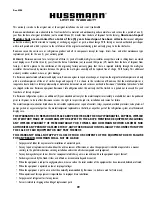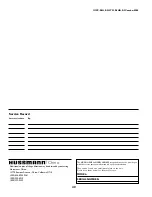
IGFP-R3H, R3HTO, R3HA, R3Combo-0208
36
Fahrenheit shall be accurate to 2
°
F. The thermometer should be
checked for proper calibration. (It should read 32
°
F when the
stem is immersed in an ice water bath).
b) LOCATION – The thermometer must be inserted into the food
itself to acquire proper food pulp temperature.
c) READING – The thermometer reading should be made only
after it has been allowed to stabilize, i.e., maintain a constant
reading.
Loading Product: Cases should be allowed to heat up for one
hour before product is loaded.
Temperature adjustments: Allow 4 hours after adjustment has
been made before testing pulp temperature of product.
d) OTHER OBSERVATIONS – Other observations should be made
which may indicate operating problems, such as unsatisfactory
product, feel/appearance.
APPENDIX D. – Recommendations to user
Refrigerated
1.0 Hussmann should provide instructions and recommendations for
proper periodic cleaning. The user will be responsible for such
cleaning, including the cleaning of low temperature equipment within
the compartment and the cooling coil area(s). Cleaning practices,
particularly with respect to proper refrigerator unloading and warm-
up, must be in accordance with applicable recommendations.
1.1 Cleaning of non frozen food equipment should include a weekly cleaning
of the food compartment as a minimum to prevent bacteria growth from
accumulating. Actual use and products may dictate more frequent cleaning.
Circumstances of use and equipment design must also dictate the frequency
of cleaning the display areas. Weekly washing down of the storage
compartment is also recommended, especially for equipment subject to
drippage of milk or other liquids, or the collection of vegetable, meat,
crumbs, etc. or other debris or litter. Daily cleaning of the external areas
surrounding the storage or display compartments with detergent and water
will keep the equipment presentable and prevent grime buildup.
1.2 Load levels as defined by Hussmann must be observed.
1.3 The best preservation is achieved by following these rules:
a) Buy quality products.
b) Receive perishables from transit equipment at the ideal temperature
for the particular product.
c) Expedite perishables to the store’s storage equipment to avoid
unnecessary warm-up and prolonged temperature recovery. Food
store refrigerators are not food chillers nor can they reclaim quality
lost through previous mishandling.
d) Care must be taken when cross merchandising products to ensure
that potentially hazardous vegetable products are not placed in non
refrigerated areas.
e) Display and storage equipment doors should be kept closed during
periods of inactivity.
f) Minimize the transfer time of perishables from storage to display.
g) Keep meat under refrigeration in meat cutting and processing area
except for the few moments it is being handled in processing. When
a cut or tray of meat is not to be worked on immediately, the
procedure should call for returning it to refrigeration.
h) Keep tools clean and sanitized. Since mechanical equipment is used
for fresh meat processing, all such equipment should be cleaned at
least daily and each time a different kind of meat product comes
in contact with the tool or equipment.
i) Make sure that all refrigeration equipment is installed and adjusted
in strict accordance with Hussmann’s recommendations.
j) See that all storage and refrigeration equipment is kept in proper
working order by routine maintenance.
Hot
1.0 Hussmann should provide instructions and recommendations for
proper periodic cleaning. The user will be responsible for such
cleaning, including the cleaning of equipment within the compartment
and the hot area(s). Cleaning practices, particularly with respect to
proper refrigerator unloading and warm-up, must be in accordance
with applicable recommendations.
1. Allow the case to preheat for one hour prior to loading.
2. Hot foods should enter the case directly after cooking or no
lower than 150
°
- 160
°
F. The Hot Cases are not designed to
heat up or cook food.
3. Self Service - be sure to display product in single layer in
direct contact with heating surface and/or wire rack.
4. All griddle type units are designed to maintain termperatures
above the FDA guideline of 140
°
F. This is product temperature,
not air or griddle temperature. Due to the open design of
these units, they must be loaded with product for proper
operation. When units are empty, they experience rapid rise of
heated air from air outside the case. This action gives empty
units a false, lower than desired, temperature reading. Loading
the case traps the air at the griddle, raising temperatures to
the 165
°
F to 185
°
F range, keeping product well above the
FDA guidelines. Remember, these units must be loaded with
product to maintain safe product temperature.
5. Check the food pulp temperature frequently with a thermom-
eter to make sure it is at the proper holding temperature. Hot
foods should be at 140
°
. The thermometer must be inserted
into the food itself for the proper temperature.
6. Do not display more food than will be sold within a 4 hour
period.
7. When restocking, bring older food to the front, and stock
fresher food on top.
8. Clean spills as soon as they happen.
9. Fingerprints and food splatter will drastically shorten bulb life.
Clean splatter off the bulbs immediately with a soft cloth.
When handling bulbs, wear cotton gloves or use a cotton rag /
Содержание Specialty Products R3H
Страница 38: ...IGFP R3H R3HTO R3HA R3Combo 0208 38 ...

